
Crevice weaver spiders (Filistatidae) comprise cribellate spiders with features that have been regarded as "primitive" for araneomorph spiders. They are weavers of funnel or tube webs. The family contains 18 genera and more than 120 described species worldwide.

Afraflacilla is a genus of the spider family Salticidae. Most species are distributed in Eastern to Northern Africa and Australia, with two species found in Europe. This genus was for a time included in the genus Pseudicius, and the boundaries between both genera are disputed. In 2016 Jerzy Prószyński erected the genus Psenuc for some borderline species. The name Afraflacilla is combined from Africa, where most earlier described species were found, and FlacillaSimon, 1901, an obsolete salticid genus now called FlacillulaStrand, 1932. This genus name is in turn derived from Aelia Flaccilla, wife of Roman Emperor Theodosius I. Afraflacilla, Pseudicius, Festucula and Marchena are close relatives and form a monophyletic group.
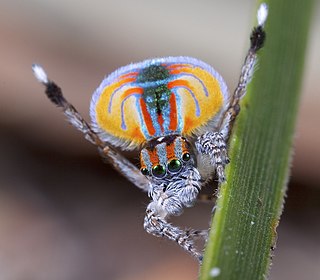
Maratus is a spider genus of the family Salticidae. These spiders are commonly referred to as peacock spiders due to the males' colorful and usually iridescent patterns on the upper surface of the abdomen often enhanced with lateral flaps or bristles, which they display during courtship. Females lack these bright colors, being cryptic in appearance. In at least one species, Maratus vespertilio, the expansion of the flaps also occurs during ritualised contests between males. The male display and courtship dance are complex, involving visual and vibratory signals.

Simaetha is a genus of Australasian jumping spiders that was first described by Tamerlan Thorell in 1881. They resemble members of Simaethula and Stertinius.

Gradungulidae, also known as large-clawed spiders, is a spider family endemic to Australia and New Zealand. They are medium to large-sized haplogyne spiders with three claws and two pairs of book-lungs similar to Mygalomorphae. Some species build extensive webs with an upper retreat tangle and connecting threads to scaffolding. This supports the ladder-like catching platform that is glued to the ground. Progradungula, a large spider with long legs like Hickmania, and Macrogradungula are the only cribellate genera of the family.
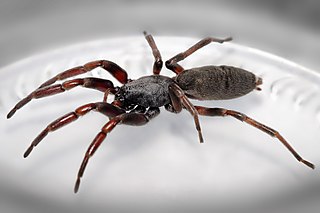
Lampona is a genus of South Pacific spiders in the family Lamponidae that was first described by Tamerlan Thorell in 1869. At least two species have a whitish tip to the abdomen and are known as "white-tailed spiders". Both hunt other spiders and have been introduced to New Zealand. The name is derived from the Middle English laumpe, meaning "light" or "fire".

The first colonies of the British Empire on the continent of Australia were the penal colony of New South Wales, founded in 1788, and the Swan River Colony, founded in 1829. Over the next few decades, the colonies of New Zealand, Queensland, South Australia, Van Diemen's Land, and Victoria were created from New South Wales, as well as an aborted Colony of North Australia. On 1 January 1901, these colonies, excepting New Zealand, became states in the Commonwealth of Australia. Since federation, the internal borders have remained mostly stable, except for the creation of some territories with limited self-government: the Northern Territory from South Australia, to govern the vast, sparsely populated centre of the country; the split of the Northern Territory into Central Australia and North Australia, and then the quick merger of those back into the Northern Territory; and the Australian Capital Territory, a federal district ceded from New South Wales.

Holconia is a genus of Southern Pacific huntsman spiders that was first described by Tamerlan Dahls Thorell in 1877. It was branched from Isopeda in 1990.

Tamopsis is a genus of tree trunk spiders that was first described by B. Baehr & M. Baehr in 1987. Like other members of the family, they may be called two-tailed spiders, referring to two elongated spinnerets. The name is derived from the genus Tama and the Ancient Greek ὄψις, meaning "resembling".
Poecilipta is a genus of South Pacific corinnid sac spiders first described by Eugène Simon in 1897.
Tarlina is a genus of Australian large-clawed spiders that was first described by Raymond Robert Forster, Norman I. Platnick & Michael R. Gray in 1987.
Therlinya is a genus of Australian sheetweb spiders that was first described by M. R. Gray & H. M. Smith in 2002.
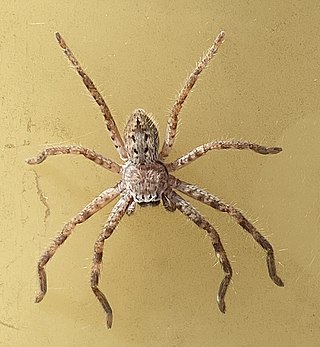
Isopedella is a genus of huntsman spiders that was first described by D. B. Hirst in 1990.
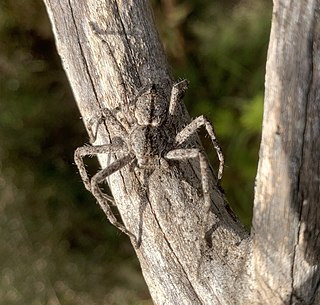
Pediana is a genus of huntsman spiders that was first described by Eugène Louis Simon in 1880.
Molycria is a genus of Australian ground spiders that was first described by Eugène Louis Simon in 1887.
Wydundra is a genus of ground spiders that was first described by Norman I. Platnick & Barbara Baehr in 2006. Originally placed with the long-spinneret ground spiders, it was transferred to the ground spiders in 2018.
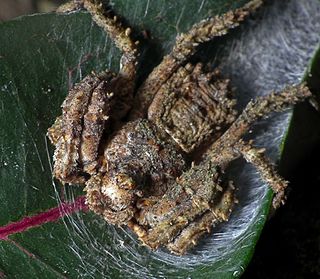
Stephanopis is a genus of crab spiders first described by Octavius Pickard-Cambridge in 1869. It was erected for five then newly described species, including S. altifrons, from Australia. Stephanopis was characterized by the high cephalic region with unequally sized anterior eyes disposed in a strongly recurved row, opisthosoma ending in several spiniform projections and dorsoventrally depressed habitus. According to Pickard-Cambridge, the single specimen used for the description of S. altifrons was dry-pinned. Therefore the specimen could not be properly examined, so it was not possible to determine if the specimen was adult. Moreover, he states his own sketch of the spider as “hasty” or "dull". This may explain why the somatic characters were inadequately described, genitalic features were not mentioned at all, and the illustrations were not detailed enough, making the species unidentifiable.
Pungalina is a genus of Australian jumping spiders that was first described by Barry J. Richardson in 2013.

Hortophora is a genus of South Pacific orb-weaver spiders first described by V. W. Framenau, R. L. C. Baptista and F. S. M. Oliveira in 2021.












